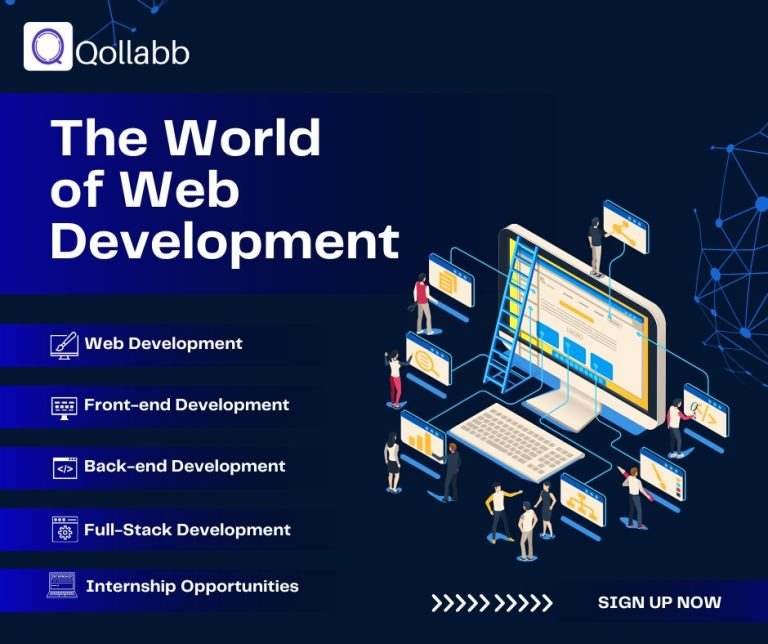Web development is a fascinating field encompassing the creation, maintenance, and optimization of websites. It combines various disciplines such as programming, design, and content creation to deliver seamless online experiences. As the internet evolves, so do the opportunities for innovation and creativity in web development.
What is Web Development?
Web development refers to the tasks associated with developing websites for hosting via intranet or internet. The web development process includes web design, web content development, client-side/server-side scripting, and network security configuration, among other tasks. Web development can range from developing a simple single static page of plain text to complex web applications, electronic businesses, and social network services.
Front-End Development
Front-end development, also known as client-side development, involves everything that users experience directly on the web page. This includes the layout, design, and interactivity. Technologies commonly used in front-end development include HTML, CSS, and JavaScript.
HTML (HyperText Markup Language)
HTML is the standard markup language for creating web pages. It describes the structure of a web page and consists of a series of elements that define different parts of the content, such as headings, paragraphs, links, and images.
CSS (Cascading Style Sheets)
CSS is used to control the presentation of a web page. It allows developers to separate content from design, making it easier to maintain and update the look and feel of a site. CSS enables the styling of text, layout, colors, and other design aspects.
JavaScript
JavaScript is a programming language that enables interactive web pages. It allows developers to implement complex features such as dynamic content updates, form validations, animations, and more. JavaScript frameworks and libraries like React, Angular, and Vue.js have further enhanced front-end development by providing reusable components and efficient workflows.
Back-End Development
Back-end development, or server-side development, focuses on the server, database, and application logic that power the front-end of a website. It ensures that the front-end can function correctly by managing data storage, user authentication, and business logic.
Server-Side Languages
Popular server-side programming languages include PHP, Python, Ruby, Java, and Node.js. These languages handle requests from the client-side, process them, and send the appropriate responses back to the user.
Databases
Databases store and manage data for websites. There are two main types of databases: relational databases (SQL) and non-relational databases (NoSQL). SQL databases like MySQL, PostgreSQL, and SQLite use structured query language to manage data, while NoSQL databases like MongoDB and Cassandra offer flexible data storage and retrieval methods.
Full-Stack Development
Full-stack development encompasses both front-end and back-end development, providing professionals with versatile skills to manage a wide range of tasks across web applications. These developers are adept at handling both client-side and server-side aspects, making them invaluable assets to any development team. Their ability to seamlessly integrate user-facing interfaces with robust server logic ensures comprehensive solutions that meet modern digital demands effectively.
Internship Opportunities in Web Development
Internships are pivotal for gaining practical skills and preparing for careers in web development. Explore internship opportunities in PHP, JavaScript, and UI/UX design to kickstart your journey.
PHP Internships: Backend Brilliance
PHP internships provide invaluable experience in server-side scripting, database management, and ensuring website functionality. Participants engage in hands-on learning by tackling real projects that involve managing databases and implementing server-side logic. These internships pave a solid career path, as PHP skills remain in high demand, particularly in web development. Mastering PHP opens doors to diverse opportunities, from creating dynamic web applications to maintaining existing websites. These skills are crucial for businesses aiming to establish a robust online presence. By gaining practical skills in PHP, interns not only enhance their technical proficiency but also prepare themselves for a competitive job market where expertise in server-side technologies is highly sought after.
JavaScript Internships: Front-End Mastery
JavaScript internships focus on developing skills in client-side programming, emphasizing the creation of interactive and responsive web interfaces. Interns gain hands-on experience in implementing dynamic web development features such as animations and form validations. This practical training is crucial for mastering JavaScript, a foundational language in modern web development that drives user interaction and enhances website functionality. Proficiency in JavaScript opens doors to diverse career opportunities, enabling interns to pursue roles where strong client-side programming skills are highly valued. By participating in JavaScript internships, individuals not only deepen their technical expertise but also prepare themselves for a dynamic industry where innovation and user-centric design play pivotal roles in shaping the digital landscape.
UI/UX Internships: Designing User-Centric Experiences
UI/UX internships concentrate on crafting visually appealing and user-friendly interfaces, critical for optimizing website usability. Interns cultivate design skills that emphasize aesthetics and user-centric principles, essential for creating engaging digital experiences. This hands-on experience is pivotal in mastering UI/UX fundamentals, enabling interns to contribute effectively to enhancing digital product success and user satisfaction. Proficiency in UI/UX design not only enriches career prospects but also positions individuals to drive innovation in web and app development. By participating in UI/UX internships, individuals gain practical insights into designing intuitive interfaces that meet user expectations and business objectives, thereby playing a crucial role in shaping the future of digital interaction.
Synergy in Web Development: Integrating Front-End and Back-End Technologies
Web development thrives on synergizing front-end user experiences with robust back-end functionalities. PHP drives server-side operations, JavaScript enhances client-side interactions, and UI/UX design ensures intuitive user interfaces. This integrated approach enhances user experience by seamlessly combining PHP’s server-side power, JavaScript’s dynamic client-side interactions, and UI/UX design’s intuitive interface creation. This synergy not only elevates website usability but also prepares developers for diverse web development challenges, fostering career readiness in full-stack proficiency. By mastering these interconnected technologies, developers gain the skills needed to create responsive, interactive, and visually appealing web applications that meet modern digital demands effectively. This holistic understanding of web development empowers professionals to deliver innovative solutions that enhance both user satisfaction and business success.
Conclusion: Embracing the Future of Web Development
Web development offers boundless opportunities for growth and innovation. Whether pursuing front-end design, back-end programming, or full-stack expertise, internships provide essential hands-on experience. Stay updated with evolving technologies like PWAs, AI, and Jamstack to remain competitive in this dynamic field. Embark on your web development journey today, armed with foundational knowledge and practical skills. Shape the future of digital experiences with creativity, technical prowess, and a passion for innovation in web development.





